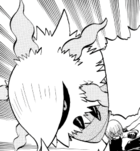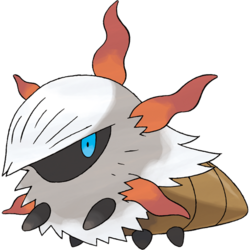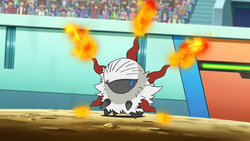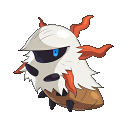From Bulbapedia, the community-driven Pokémon encyclopedia.
|
|
| Line 233: |
Line 233: |
|
| |
|
| ==Trivia== | | ==Trivia== |
| * Out of all Pokémon that evolve by a set level, Larvesta evolves later than any other unevolved Pokémon, at level 59. | | * Out of all Pokémon that evolve by a set level, Larvesta evolves later than any other unevolved Pokémon, at level 59. |
| * No other Pokémon has the same [[type]] [[List of Pokémon with unique type combinations|combination]] as Larvesta and its {{p|Volcarona|evolution}}. | | * No other Pokémon has the same [[type]] [[List of Pokémon with unique type combinations|combination]] as Larvesta and its {{p|Volcarona|evolution}}. |
| * For reasons unknown, Larvesta and Volcarona could not learn {{m|Attract}} in [[Generation V]], despite having genders and being compatible with other TMs. They share this trait with {{p|Nincada}}, {{p|Ferroseed}}, and {{p|Ferrothorn}}. | | * For an unknown reason, Larvesta and Volcarona cannot learn {{m|Attract}} in [[Generation V]], despite having genders and being compatible with other [[TM]]s. They share this trait with {{p|Nincada}}, {{p|Ferroseed}}, and {{p|Ferrothorn}}. |
| * Larvesta, along with its evolution, are the only known Pokémon with a double weakness to the {{type|Rock}} that are not {{type|Flying}}s. | | * Larvesta and Volcarona are the only known Pokémon with a double weakness to the {{t|Rock}} type that are not {{t|Flying}} types. |
| ** This makes it the Pokémon that can naturally take the most damage from [[entry hazard|entry hazards]], taking maximum damage from {{m|Stealth Rock}} and being affected by {{m|Spikes}}. | | ** This makes it the Pokémon that can naturally take the most damage from [[entry hazard|entry hazards]], taking maximum damage from {{m|Stealth Rock}} and being affected by {{m|Spikes}}. |
|
| |
|
Revision as of 15:33, 9 January 2014
Larvesta (Japanese: メラルバ Merlarva) is a dual-type Bug/Fire Pokémon.
It evolves into Volcarona starting at level 59.
Biology

Larvesta "flying" using the fire that spits out from its horns
Larvesta is a fuzzy, moth larva-like Pokémon. It has blue eyes in a shadowed face. Its white mane of fuzz encompasses its head and the upper half of its body, while its lower half is brown. It has three pairs of small black legs. There are five orange, slightly whorled horns on the sides of its head, which it can use to spit fire as a defensive tactic to deter predators. It has been seen using fire it spits from these horns to fly. It lives at the feet of volcanoes.
In the anime
Major appearances
Larvesta made its debut in The Club Battle Hearts of Fury: Emolga Versus Sawk! under the ownership of Luke, where it battled against Cilan's Stunfisk and won.
Minor appearances
Pokédex entries
| Episode
|
Pokémon
|
Source
|
Entry
|
| BW041
|
Larvesta
|
Ash's Pokédex
|
Larvesta, the Torch Pokémon. A Larvesta shoots fire from its five horns to repel its enemies. They live at the base of volcanoes.
|
|
In the manga

Larvesta in Pokémon Adventures
In the Pokémon Adventures manga
A member of the Shadow Triad used a Larvesta to attack Lenora at Nacrene City.
In the TCG
- Main article: Larvesta (TCG)
Game data
Pokédex entries
| This Pokémon was unavailable prior to Generation V.
|
|
|
|
|
|
|
|
|
| Generation V
|
|
| Black
|
This Pokémon was believed to have been born from the sun. When it evolves, its entire body is engulfed in flames.
|
| White
|
The base of volcanoes is where they make their homes. They shoot fire from their five horns to repel attacking enemies.
|
| Black 2
|
Said to have been born from the sun, it spews fire from its horns and encases itself in a cocoon of fire when it evolves.
|
| White 2
|
{{{white2dex}}}
|
|
|
| Generation VI
|
|
| X
|
Said to have been born from the sun, it spews fire from its horns and encases itself in a cocoon of fire when it evolves.
|
| Y
|
The base of volcanoes is where they make their homes. They shoot fire from their five horns to repel attacking enemies.
|
|
|
Game locations
| This Pokémon was unavailable prior to Generation V.
|
|
|
|
|
|
|
|
|
|
|
|
|
In side games
Held items
Stats
Base stats
| Stat
|
Range
|
| At Lv. 50
|
At Lv. 100
|
55
|
|
115 - 162
|
220 - 314
|
85
|
|
81 - 150
|
157 - 295
|
55
|
|
54 - 117
|
103 - 229
|
50
|
|
49 - 112
|
94 - 218
|
55
|
|
54 - 117
|
103 - 229
|
60
|
|
58 - 123
|
112 - 240
|
Total: 360
|
Other Pokémon with this total
|
- Minimum stats are calculated with 0 EVs, IVs of 0, and (if applicable) a hindering nature.
- Maximum stats are calculated with 252 EVs, IVs of 31, and (if applicable) a helpful nature.
|
Type effectiveness
| Under normal battle conditions in Generation IX, this Pokémon is:
|
|
|
|
|
|
|
|
|
|
|
|
|
Learnset
|
|
|
|
- Bold indicates a move that gets STAB when used by Larvesta
- Italic indicates a move that gets STAB only when used by an Evolution of Larvesta
- Click on the generation numbers at the top to see level-up moves from other generations
|
|
|
|
|
- Bold indicates a move that gets STAB when used by Larvesta
- Italic indicates a move that gets STAB only when used by an Evolution of Larvesta
- Click on the generation numbers at the top to see TM moves from other generations
|
|
|
|
|
- Moves marked with an asterisk (*) must be chain bred onto Larvesta in Generation VI
- Moves marked with a double dagger (‡) can only be bred from a Pokémon who learned the move in an earlier generation.
- Moves marked with a superscript game abbreviation can only be bred onto Larvesta in that game.
- Bold indicates a move that gets STAB when used by Larvesta
- Italic indicates a move that gets STAB only when used by an Evolution of Larvesta
- Click on the generation numbers at the top to see Egg moves from other generations
|
|
|
|
|
- A black or white abbreviation in a colored box indicates that Larvesta can be tutored the move in that game
- A colored abbreviation in a white box indicates that Larvesta cannot be tutored the move in that game
- Bold indicates a move that gets STAB when used by Larvesta
- Italic indicates a move that gets STAB only when used by an Evolution of Larvesta
- Click on the generation numbers at the top to see Move Tutor moves from other generations
|
Side game data
Evolution
Sprites
Trivia
- Out of all Pokémon that evolve by a set level, Larvesta evolves later than any other unevolved Pokémon, at level 59.
- No other Pokémon has the same type combination as Larvesta and its evolution.
- For an unknown reason, Larvesta and Volcarona cannot learn Attract in Generation V, despite having genders and being compatible with other TMs. They share this trait with Nincada, Ferroseed, and Ferrothorn.
- Larvesta and Volcarona are the only known Pokémon with a double weakness to the Rock type that are not Flying types.
- This makes it the Pokémon that can naturally take the most damage from entry hazards, taking maximum damage from Stealth Rock and being affected by Spikes.
Origin
Larvesta is based on a moth and the famed Japanese monument, the Tower of the Sun. Larvesta appears to be based on an Atlas moth larva. The way its red growths are shaped and positioned on its circular body may be a reference to the sun, or to the Daimonji. It may also be based on a torch.
Name origin
Larvesta is a combination of larva and Vesta (Roman goddess of the hearth and home, symbolised and represented by an eternally-burning fire located in her temple). It may also involve lava.
Merlarva may be a combination of めらめら meramera (onomatopoeia for flaring) and larva.
In other languages
| Language
|
Title
|
Meaning
|
 Japanese Japanese
|
メラルバ Merlarva
|
From めらめら meramera, and larva
|
 French French
|
Pyronille
|
From the prefix pyro and chenille
|
 Spanish Spanish
|
Larvesta
|
Same as English name
|
 German German
|
Ignivor
|
From ignis and vor
|
 Italian Italian
|
Larvesta
|
Same as English name
|
 Korean Korean
|
활화르바 Hwalhwareuba
|
From 활활 hwalhwal and larva
|
 Mandarin Chinese Mandarin Chinese
|
燃燒蟲 / 燃烧虫 Ránshāochóng
|
From 燃燒 ránshāo and 蟲 chóng
|
 Cantonese Chinese Cantonese Chinese
|
|
|
|
|
|
|
|
|
|
Notes
External links

|
This Pokémon article is part of Project Pokédex, a Bulbapedia project that aims to write comprehensive articles on each Pokémon species, as well as Pokémon groups and forms.
|
















